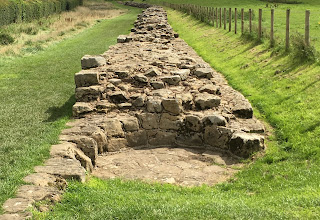On the way up the hill, we spotted these British phone booths, holdovers from another era and in immaculate condition. They appeared to be operational even to this day, although - as in this country - everyone, including children in strollers, seems to have a mobile phone surgically attached to their hands and unusually large thumbs.
We also spotted this unusual sign on a sidewalk outside a cafe that had just opened. Since my face is still a little hairy, I did not enter, although I take it I would have been welcome,
We also passed this mere church, this "ordinary" structure, on the way to the magnificent structure protruding above the buildings before us. It was St. Nicholas’s Church (Church of England), and in any city in this country would have been extraordinary. Here it was dwarfed by Durham Cathedral.
Although there are some exceptions, generally if a town or village in England has a cathedral it is known as a city. In this case the cathedral was the Cathedral Church of Christ, Blessed Mary the Virgin, and St. Cuthbert or Durham, called more simply Durham Cathedral, ca. 1093.
Yes, ca. 1093. I let that date sink in. 926 years ago. This church had been standing on this spot for 527 years when the Pilgrims landed at Plymouth Rock. I chatted with some of our other travelers as we marveled at the architecture, the engineering, and the construction techniques that went into building this beautiful 217-foot tall stone structure, when the tools were primitive and the rocks would have been hauled up this hill from area quarries in horse-drawn carts. Long before the invention of steel, there was not a crack to be seen anywhere.
We tiptoed through the imposing door, removed our hats, and gazed in awe at the stained glass windows and carved stone columns.
I stood in the rear and listened to part of an interesting sermon being delivered by the Priest, touching upon the current unrest surrounding Brexit - they apparently did not shy away from politics - and how important it was not to become spiritually unmoored by the uncertainty of the future.
We walked across the green and ate a light lunch in the Durham University Cafe, operated by friendly students - vegetarian paninis of caramelized onions, tomato, rocket, and roasted aubergine - that would have been welcome on an American lunch menu, except that I had to look up "rocket" (arugula) and "aubergines" (eggplant).
We stopped not far out of Durham to view another historical icon, a remnant of Hadrian's Wall. The wall was begun by Romans in AD 122. Now that is a date to consider; it makes a 1093 cathedral we had just seen seem like a modern building.
The road kept climbing higher and higher as we traveled north, and finally at the crest of the mountain we crossed into Scotland.
A few miles into Scotland, we stopped at the picturesque town of Jedburgh, famous for the ruins of Jedgurgh Abbey, a ruined Augustinian abbey from the 12th century.
I walked up to the top of the street past the ruins, and saw that Jedburgh was a pleasant little place, with cafes and pubs and little shops - the kind of village that I did not think existed anymore in Britain. "I could live here!" I found myself saying, the first of many places on this trip that seemed to be especially habitable. We made out way out of Town and passed another remarkable sight - an ancient oak tree known as the Capon Tree, thought to be between 500 and 1000 years old.
We also had our first view of heather, the legendary flower of Scotland, which
blooms only twice a year and peaks in color (another traveler told me) for only
ten days. Already its purple flowers
were beginning to fade into brown.
Our travel director had given us ample time to explore on our stops, and he was also good at strategically-placed snack and bathroom breaks. We stopped at a seldom-frequented little cafe along the way for that purpose, and the grateful owner gave Steve a box of fresh shortbread, enough for him to share with the whole coach and our first genuine taste of this melt-in-your-mouth Scottish confection.
Finally, at the end of a long day, we crossed the River Tweed - one of the great salmon rivers of Scotland and also, we were told, the origin of that woollen cloth's name - and pulled up in front of the MacDonald Cardrona Hotel Golf And Spa in Peebles, our home for two nights and of all the places where we stayed on this trip perhaps my favorite. There was a lovely golf course, mountain bike and hiking trails, and stunning views all around.
Some of our fellow travelers had signed up for a dinner and
show in Edinburgh,
but we had opted for some light food in an almost-deserted downstairs dining
room, looking out the window on the golf course.
Our young waitress had a lovely Scottish accent, and we
tried to keep her in conversation as long as possible just to listen. Martha had noticed that many of the golfers
seemed to be walking the course instead of using golf carts and she asked her about
that. "It takes about five hours," she said. "Most of them walk and come back crying."
















No comments:
Post a Comment